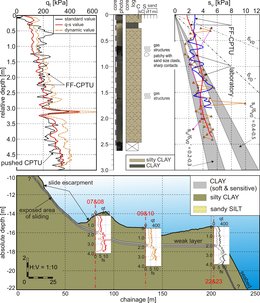Page path:
- Home
- Research
- Seafloor Dynamics
- Completed projects
- former SD projects (2013 - 2017)
- SD3 PhD projects
SD3 PhD projects
Ongoing PhD Projects
To which extend do sediment physical parameters control (I) slope failure and (II) transport mechanisms? - The /Twin Slides/ offshore southern Sicily serving as a unique case study area
The phenomena of submarine landslides and their inherent consequences occur at all margins worldwide. Many studies have mapped and monitored slides and investigated trigger mechanisms and sediment failure processes. Still, great uncertainty persists as to why a given slope fails whereas another adjacent remains stable. In this context, augmented focus is put on events of smaller scale such as the Twin Slide complex offshore southern Sicily in the highly vulnerable oceanic basin of the Mediterranean Sea.
Main objective of the PhD project is the development and evaluation of conceptional models for the evolution of the Twin Slide complex. Analysis of both geophysical data and long MeBo and shorter gravity cores acquired during research cruise MSM15/3, aligned with numerical modelling experiments, encompass the investigative framework to address the following questions:
(A) Which conceptional model fits best to the evolution of the Twin Slide complex?
(B) Do highly porous ash layers serve as potential failure and glide planes of submarine mass movements? Can specific stratigraphic surfaces be identified that act as glide planes (e.g. clay-rich and/or porous ash layers with high liquefaction potential)?
(C) Do and how do sediment-physical parameters of source material control transport mechanisms?
Main objective of the PhD project is the development and evaluation of conceptional models for the evolution of the Twin Slide complex. Analysis of both geophysical data and long MeBo and shorter gravity cores acquired during research cruise MSM15/3, aligned with numerical modelling experiments, encompass the investigative framework to address the following questions:
(A) Which conceptional model fits best to the evolution of the Twin Slide complex?
(B) Do highly porous ash layers serve as potential failure and glide planes of submarine mass movements? Can specific stratigraphic surfaces be identified that act as glide planes (e.g. clay-rich and/or porous ash layers with high liquefaction potential)?
(C) Do and how do sediment-physical parameters of source material control transport mechanisms?
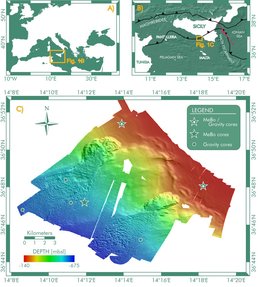
A geotechnical analysis of marine sediment deformation and failure processes in geodynamically active areas
Submarine slope failures are common along tectonically, seismically and thus oftentimes volcanically active margins and may have devastating impact on onshore and offshore infrastructure as well as coastal communities. Earthquake shaking is one of the most contemplated triggers for marine slope sediment failure. Due to cyclic shaking excess pore pressure can be induced and may lead to liquefaction of highly porous sediments (i.e. turbidite sands, silts , ash layers...etc.) or to progradational failure of more plastic sediments (i.e. clays). Likewise the occurrence of submarine slope failure without any obvious short term triggering mechanism have been reported. Sudden sediment failure can take place under static condition when peak shear strengths are exceeded by static slope sediment loading. In essence most soils show a different response to periodic loading than to static loading – making static and cyclic loading experiments compulsory for submarine slope stability and mass-movement initiation studies.
This PhD thesis deals with the geotechnical characterization of marine sediments under static and cyclic loading condition using laboratory and in situ geotechnical instruments. The MARUM Dynamic Triaxial Testing Device (DTTD) is used to investigate marine sediment's shear strength under cyclic loading conditions with special focus on earthquake shaking of porous sediments, such as sands, silts and tephras. Static shear strengths are determined in a direct shear apparatus in laboratory. For in situ characterization of sediment's shear strength the free fall Cone Penetration Testing (CPT) device comes into operation.
Within this PhD thesis a special focus will be set I) to the liquefaction susceptibility of different types of granular, porous material. Especially ash layers, provided by active margin associated volcanism, are widely discussed as potential glide planes of submarine slides and shall thus be analyzed for their liquefaction suceptibility. II) The prediction of earthquake induced sediment excess pore pressure is one of the main aims. And III) the behavior of clay and moreover 'quick' clay under static and cyclic loading conditions will be analyzed.A better understanding of the failure processes of marine sediments under different loading conditions will be achieved by empirical evidence.
This PhD thesis deals with the geotechnical characterization of marine sediments under static and cyclic loading condition using laboratory and in situ geotechnical instruments. The MARUM Dynamic Triaxial Testing Device (DTTD) is used to investigate marine sediment's shear strength under cyclic loading conditions with special focus on earthquake shaking of porous sediments, such as sands, silts and tephras. Static shear strengths are determined in a direct shear apparatus in laboratory. For in situ characterization of sediment's shear strength the free fall Cone Penetration Testing (CPT) device comes into operation.
Within this PhD thesis a special focus will be set I) to the liquefaction susceptibility of different types of granular, porous material. Especially ash layers, provided by active margin associated volcanism, are widely discussed as potential glide planes of submarine slides and shall thus be analyzed for their liquefaction suceptibility. II) The prediction of earthquake induced sediment excess pore pressure is one of the main aims. And III) the behavior of clay and moreover 'quick' clay under static and cyclic loading conditions will be analyzed.A better understanding of the failure processes of marine sediments under different loading conditions will be achieved by empirical evidence.
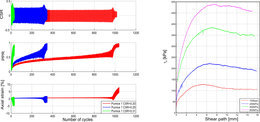
Numerical simulation of mechanics and kinematics of the Mediterranean Ridge - key role of viscous décollements
The eastern Mediterranean Sea is a complex tectonic area observable from high seismicity and active volcanism. The major tectonic feature in the Eastern Mediterranean is the Hellenic subduction zone where the Nubian Plate dips beneath the Aegean Plate. This process is associated to fault zone activity and numerous earthquakes.
As a consequence of the north-facing subduction a large sedimentary wedge evolved – the Mediterranean Ridge. Here, oceanic sediments deposited since the Mesozoic on the subducting African plate are off-scrapped and accreted to the overriding Eurasian Plate since Miocene .
In accordance to the Critical Taper Theory by DAHLEN et al. (1983), several studies have shown that the physical properties of the basal detachment of such accretionary wedges – the décollement - control their kinematics and mechanics. This also includes their dewatering behaviour and the fluid flow pathways.
Hence, the Mediterranean ridge represents an excellent case study area to investigate the key role of the strength of basal detachment as here the décollement material strongly varies along the subduction zone.
The eastern as well as western part of the Mediterranean wedge is underlying by large evaporite horizons. At some places these accumulated salt reaches a thickness of more than 1.8 - 2 km. These Messinian evaporites act as a weak décollement because of their physical properties. This results in the development of a frontal accreted, thinner wedge with a narrower taper. The taper is the smallest of any accretionary prism documented. Hence, these evaporite deposits have a wide influence on the tectonic behaviour of the wedge.
In addition, the different accretionary modes and therewith fault geometries and activities produce different dewatering behaviour, fluid migration and drainage pathways along the frontal part of the Hellenic subduction zone Hence, numerous fluid venting locations could be recognized by more than hundred mud volcanoes in the Mediterranean Ridge.
As a consequence of the north-facing subduction a large sedimentary wedge evolved – the Mediterranean Ridge. Here, oceanic sediments deposited since the Mesozoic on the subducting African plate are off-scrapped and accreted to the overriding Eurasian Plate since Miocene .
In accordance to the Critical Taper Theory by DAHLEN et al. (1983), several studies have shown that the physical properties of the basal detachment of such accretionary wedges – the décollement - control their kinematics and mechanics. This also includes their dewatering behaviour and the fluid flow pathways.
Hence, the Mediterranean ridge represents an excellent case study area to investigate the key role of the strength of basal detachment as here the décollement material strongly varies along the subduction zone.
The eastern as well as western part of the Mediterranean wedge is underlying by large evaporite horizons. At some places these accumulated salt reaches a thickness of more than 1.8 - 2 km. These Messinian evaporites act as a weak décollement because of their physical properties. This results in the development of a frontal accreted, thinner wedge with a narrower taper. The taper is the smallest of any accretionary prism documented. Hence, these evaporite deposits have a wide influence on the tectonic behaviour of the wedge.
In addition, the different accretionary modes and therewith fault geometries and activities produce different dewatering behaviour, fluid migration and drainage pathways along the frontal part of the Hellenic subduction zone Hence, numerous fluid venting locations could be recognized by more than hundred mud volcanoes in the Mediterranean Ridge.

Physical characterisation of marine slope sediments utilizing numerical 3-D experiments
Nowadays the behaviour of submarine continental slopes is unsatisfactory investigate. Important questions which are necessary to answer deals with zones of stability inside slopes. Why do zones of weakness exist and where and when do they occur? What influence the shear plane of the submarine land slide significantly? What other factors play an important role?
To answer these questions we use a numerical method which is called Discrete Element Method (DEM). The DEM is established for such scientific problems. With the help of this numerical method we can determine and analyse material properties of sediment units in microscale.
To answer these questions we use a numerical method which is called Discrete Element Method (DEM). The DEM is established for such scientific problems. With the help of this numerical method we can determine and analyse material properties of sediment units in microscale.
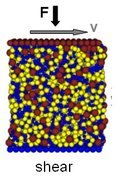
Slope stability along active and passive continental margins:a geotechnical approach
Submarine mass movements play an important role in shaping continental margins, transporting sediment to deep water. Over the last two decades, significant advancements were achieved in our understanding of the occurrence environment, precondition factor and trigger mechanism of submarine mass movements and their inherent consequences. However, many questions about the complex interplay of the various geological factors controlling submarine slope instability are still not well resolved. This Ph.D. project should contribute to understand the trigger mechanisms of submarine landslides in the active margin (Mediterranean continental margin: The Gela Basin) and passive margin (Northern Argentina and Uruguay Margin). The target of Mediterranean continental margin project is the understanding of pore pressure transients and earthquake dynamic load that control slope stability. The aim of Northern Argentina and Uruguay Margin project is the significance of rapid accumulation of fine-grained sediments and strong contour currents for submarine slope stability. In the both research areas sediment cores have already be gained including gravity cores and MeBo cores. The Ph.D. Student took geotechnical experiments of the samples came from expedition M78/3 in Northern Argentina and Uruguay Margin, and took a part on expedition MSM15/3 in Gela Basin Mediterranean continental margin in June 2009, with Prof. Dr. K. Huhn as chief scientist. The cruises were conducted by GeoB and Marum have already sampled or will sample key areas of submarine landslide deposits as well as undisturbed slope for reference. After finishing field survey and laboratory experiments, feeding the data obtained into numerical modeling, the limit equilibrium and finite element methods (FEM) were used for the evaluation of static and dynamic stabilities of the submarine slope.
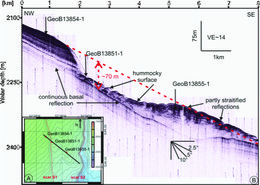
Slope Stability of Marine Sediments Using Dynamic CPTU Equipments: Examples from the Noregian Fjords, French Ligurian Coast and Gela Basin
The shear-strength and excess pore-water pressure are crucial physical/hydraulical parameters controlling the triggering mechanisms and slope instability of submarine mass movements. The determination of these physical/hydraulical parameters requires in-situ measurement- and/or coring/sampling techniques in conjunction with laboratory tests. Both techniques are addressed to the following key interests when dealing with submarine landslides: (i) characterization of the sub-seafloor sediments and (ii) development of sedimentological/geotechnical ground models.
This Ph.D. project treats with shallow-water and deep-water free-fall Piezocone Penetrometer tests (SWFF-CPTU and DWFF-CPTU) using the MARUM instruments, conventional (standard) CPTU measurements and gravity cores with associated laboratory experiments. Comparisons of these geological/geotechnical data are used to evaluate the dynamics of the free-fall instrument which accentuate the natural sediment physical/hydraulical parameters (strain-rate effect). State-of-the-art strain-rate solutions are validated for the measured/derived strength parameters (corrected cone resistance, sleeve friction) and a new strain-rate solution are developed for the measured/derived excess pore-water pressure. This strain-rate correction enables the possibility to use the free-fall Piezocone Penetrometer measurements similar as standard CPTU data.
The combination of the corrected free-fall- and standard CPTU data as well as results from laboratory experiments yields vital information on lithology, soil stratification and geotechnical engineering properties for landslide-prone regions, like Finneidfjord (Northern Norway), Nice Airport (Southern France) and Gela Basin (Southern Sicily). Additionally, these results can be used to determine sedimentological/geotechnical ground models in conjunction with geophysical data (i.e. seismic profiles).
All these findings are particularly important to improve our knowledge for the submarine slope stability evaluation, geohazard identification and risk assessment in offshore and coastal environments.
This Ph.D. project treats with shallow-water and deep-water free-fall Piezocone Penetrometer tests (SWFF-CPTU and DWFF-CPTU) using the MARUM instruments, conventional (standard) CPTU measurements and gravity cores with associated laboratory experiments. Comparisons of these geological/geotechnical data are used to evaluate the dynamics of the free-fall instrument which accentuate the natural sediment physical/hydraulical parameters (strain-rate effect). State-of-the-art strain-rate solutions are validated for the measured/derived strength parameters (corrected cone resistance, sleeve friction) and a new strain-rate solution are developed for the measured/derived excess pore-water pressure. This strain-rate correction enables the possibility to use the free-fall Piezocone Penetrometer measurements similar as standard CPTU data.
The combination of the corrected free-fall- and standard CPTU data as well as results from laboratory experiments yields vital information on lithology, soil stratification and geotechnical engineering properties for landslide-prone regions, like Finneidfjord (Northern Norway), Nice Airport (Southern France) and Gela Basin (Southern Sicily). Additionally, these results can be used to determine sedimentological/geotechnical ground models in conjunction with geophysical data (i.e. seismic profiles).
All these findings are particularly important to improve our knowledge for the submarine slope stability evaluation, geohazard identification and risk assessment in offshore and coastal environments.
